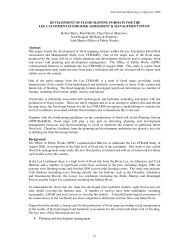OPW Guidelines & Schedules A - B Coastal Erosion Risk ...
OPW Guidelines & Schedules A - B Coastal Erosion Risk ...
OPW Guidelines & Schedules A - B Coastal Erosion Risk ...
Create successful ePaper yourself
Turn your PDF publications into a flip-book with our unique Google optimized e-Paper software.
(ix)<br />
(x)<br />
(xi)<br />
It is important to note that existing coastal protection works, which are<br />
proposed to be replaced by new works, should not be included as a<br />
benefit although any assets being protected by existing works or<br />
scheme, e.g. a promenade, may be included as a benefit.<br />
The loss of infrastructure integral to the properties at risk from erosion<br />
e.g. power, phone, gas utilities and local access roads should not be<br />
included as an additional benefit. Where infrastructure is providing a<br />
service to an area free from erosion, but is itself threatened by erosion,<br />
then it should be included as a benefit in the form of provision of a<br />
least cost alternative.<br />
In respect of the loss of agricultural land, the current market value<br />
should be used together with a multiplier to capture the subsidy value<br />
of the land. A multiplier of 65% should thus be used.<br />
Methodology<br />
The simple methodology for calculating the economic benefits or Nett Present Value<br />
of Benefits for minor coastal erosion prevention schemes are outlined below in 3<br />
steps.<br />
Step 1: Collect Relevant Data, Estimate <strong>Erosion</strong> Rates and Contours<br />
Identify and outline the extent of coastline affected by erosion from a site inspection<br />
and careful review of all relevant available information (historical aerial photography,<br />
beach photographic and topographic surveys, maps, charts etc). Estimate the annual<br />
average rate(s) of erosion. Prepare erosion contours at regular time intervals, typically<br />
5 years, for a period of at least the expected design life of the scheme. Use smaller<br />
time intervals for high erosion rates (> 1.5 m/year).<br />
Step 2: Collect Valuation Data for Properties and Assets at <strong>Risk</strong><br />
Identify and tabulate all erosion prone property, land and/or assets in the erosion<br />
prone area over the design life of the scheme.<br />
Determine or estimate the current erosion-free market value (MV) of each erosionprone<br />
property, land area and/or assets and their expected year of loss to erosion both<br />
with and without the proposed scheme. Allow a safety margin of typically 2 years to<br />
determine the time of loss (year) of the particular property, land and/or assets.<br />
In the case where a property or asset is not accessible or useable due to prior loss of<br />
access or utilities from erosion then the time of loss of this property or asset may be<br />
thus brought forward.<br />
Step 3: Calculate the Nett Present Value of Scheme Benefits<br />
The methodology involves the calculation of the discounted value of property, land<br />
and/or asset losses with erosion protection less those without a protection scheme.<br />
The result is a Nett Present Value of Benefits associated with the proposed scheme.
















